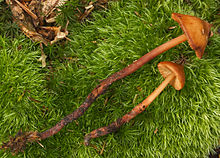Phaeocollybia christinae
Found in the woodlands of Europe and eastern North America, it typically grows in sandy soil near conifer trees, especially spruce.
The fruit bodies are characterized by a brownish cap with a pointed umbo, and a long stem that extends deeply into the soil.
[3] The species obtained the name by which it is known today when Roger Heim transferred it to Phaeocollybia in 1931.
Depending on the age of the fruit body and the levels of moisture in the environment, the cap may be sticky or moist.
They are initially pallid before becoming fulvous to deep reddish-yellow, slightly spotted, and shining.
[5] Fruit bodies of Phaeocollybia christinae grow scattered or in groups, deeply rooted in moss or leaf litter.
